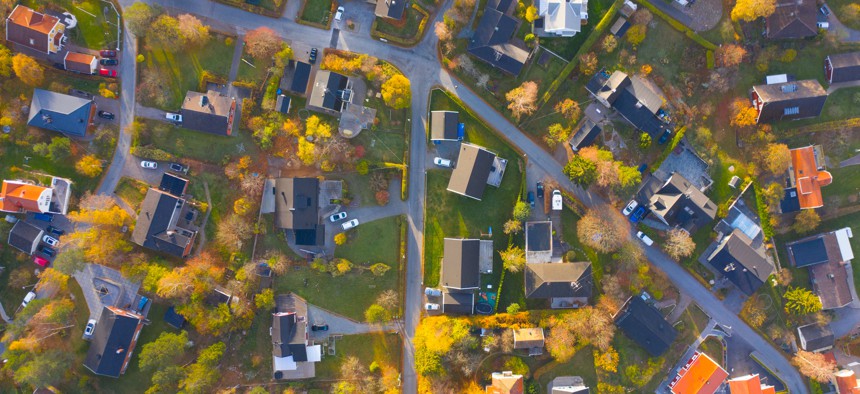Visualizing Vulnerability: County Maps Show Areas of Greatest Need

olaser / Getty Images
To study equity differences at systemic and place-based levels, Fairfax County put census data on color-coded maps so that officials can quickly see areas of greatest need.
Fairfax County, Virginia, is using data and mapping to increase equity across its population of 1.2 million.
“We really have utilized data to help us understand this idea of ‘situatedness’ – how are people situated in the county and how then can we target our strategies to account for that difference in situatedness,” said Karla Bruce, the county’s chief equity officer.
Although officials knew that some county residents were faring better than others because of programmatic data, they needed to study the differences at systemic and place-based levels, she said, and spatial data has provided that opportunity. When officials see areas of vulnerability, they can use the data to understand what’s driving it – for instance, a lack of access to transportation or health care.
The result is the Fairfax County Vulnerability Index (VI), which uses data from the Census Bureau’s (ACS). It creates scores based on eight indicators, such low-income occupations, low English-speaking ability, households without a vehicle and homeownership. Scores are given to each census tract for each indicator.
Using Esri Business Analyst, a demographic mapping software tool, Katie Miga, business analytics supervisor at the Fairfax County Park Authority, puts the data on color-coded maps so that officials can see at a glance what areas have the greatest need.
Business Analyst allows users to apportion data to different geographies, such as planning districts. “Census doesn’t put out data at our planning district level,” Miga said. “Having that additional tool is really helpful to be able to take in the census data and then say, ‘OK, but I don’t just want it at census geographies. I want it at our geographies.’”
One example of how the county uses VI is in affordable housing. Traditionally, it was built in areas where land was cheapest, Bruce said. “Those are also areas where opportunity is lowest, so we’re basically putting people in conditions where they’re not able to access opportunities to thrive and live to their fullest potential. So we’re really shifting our practice in looking for opportunities to locate our affordable housing in areas where opportunity already exists -- opportunity for jobs, access to healthier food, access to transportation,” she said.
The county’s Urban Forestry Management Division combined VI with its data on tree canopy coverage to determine where to plant trees, while the Department of Public Works and Environmental Services used it when working with Dominion Energy to convert about 60,000 streetlights to LED. Initially, engineers replaced the oldest bulbs first. When they added VI to the decision-making process, they found that was still the best approach because the older, less-efficient bulb technology was most common in areas with high VI scores.
Additionally, the Fairfax County Health Department used VI to help determine where to set up weekend and after-hour clinics for COVID-19 vaccinations for children ages 5 to 11, and the Park Authority has used it to help determine what areas would benefit from rec center scholarships that would increase access to classes and services.
Future analyses include incorporating VI into planning for parks and open space. “Previously the planning was a ratio of how many soccer fields are within 5 miles of a certain amount of population, but there was no look at ‘let’s make sure everyone has access,’” Miga said. “The vulnerability index is really just to highlight disparities within a geographical area because if you look at the county numbers overall … we look like we’re fine, but if you break it down to specific areas by census tract or block group, it’s very obvious it’s not the case for everyone. Everyone’s not doing well.”
Based in part on its work with Fairfax County, in January, Esri released the Social Equity Analysis Solution in partnership with Race Forward’s Government Alliance on Race and Equity. Race Forward is a nonprofit racial justice organization. The solution, which works with ArcGIS software can help communities identify populations by race, age, ethnicity or other factors; understand the distribution of benefits by geographic region; and evaluate progress toward equity goals.
One way that marrying mapping and ACS data has helped in Fairfax County is by targeting outreach, Bruce said.
“Sometimes our programmatic data, while it indicated a problem at an individual level, we weren’t able to aggregate it to show where something was happening,” she said. “If we had a sense of an issue, we would apply our strategy across the board. I think this has allowed us to be better able to tailor our issues based on our understanding of opportunities and vulnerability in different areas.”
It’s easy for any agency with a geographic information systems analyst to add indicators as needed, Miga added. For instance, the county’s Office for Children added the 5 and younger subset of the population to better understand disparities in early childhood.
“It really helps us to target intervention and build the political will and public will to support those what we would call pro-equity policies,” Bruce said. “Without that evidence and without that ability to demonstrate that situatedness, I think it can be difficult to advocate.”
Stephanie Kanowitz is a freelance writer based in northern Virginia.





